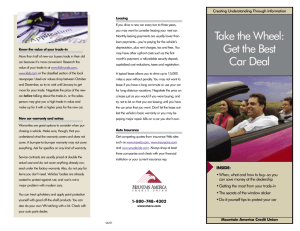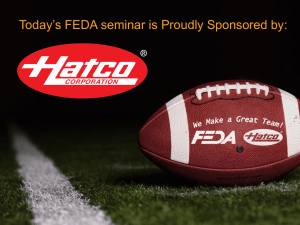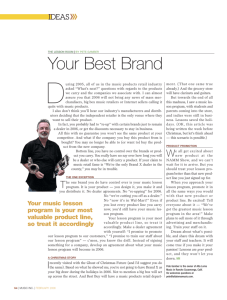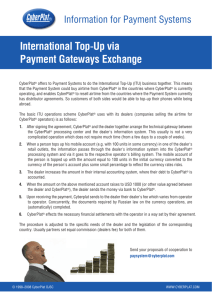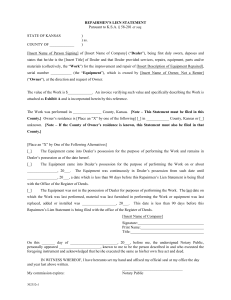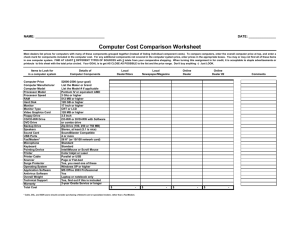Trading in Your Old Car
advertisement
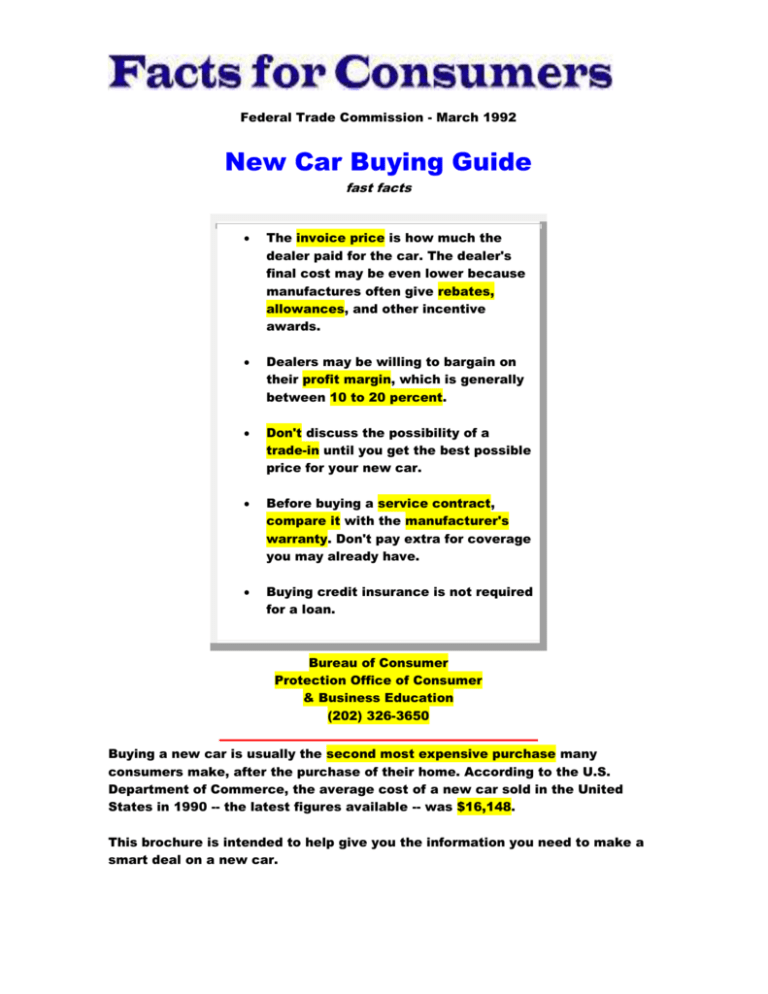
Federal Trade Commission - March 1992 New Car Buying Guide fast facts The invoice price is how much the dealer paid for the car. The dealer's final cost may be even lower because manufactures often give rebates, allowances, and other incentive awards. Dealers may be willing to bargain on their profit margin, which is generally between 10 to 20 percent. Don't discuss the possibility of a trade-in until you get the best possible price for your new car. Before buying a service contract, compare it with the manufacturer's warranty. Don't pay extra for coverage you may already have. Buying credit insurance is not required for a loan. Bureau of Consumer Protection Office of Consumer & Business Education (202) 326-3650 Buying a new car is usually the second most expensive purchase many consumers make, after the purchase of their home. According to the U.S. Department of Commerce, the average cost of a new car sold in the United States in 1990 -- the latest figures available -- was $16,148. This brochure is intended to help give you the information you need to make a smart deal on a new car. Buying Your New Car Before you step into a dealer's showroom, it helps to know what car model and options you want and how much you are willing to spend. That way, you are less likely to feel pressured into making a hasty or expensive decision and more likely to get a better deal. To help you shop, you may want to consider these suggestions: Check Internet sites that discuss new car features and prices. These may provide information on the dealer's costs for specific models and options. Shop around to get the best possible price by comparing models and prices at dealer showrooms. You also may want to contact car-buying services and broker-buying services to make comparisons. Plan to negotiate on price. Dealers may be willing to bargain on their profit margin, which is generally between 10 to 20 percent. This is usually the difference between the manufacturer's suggested retail price and the invoice price. To help you do this, refer to the worksheet listed at the end of this brochure. Consider ordering your new car if you do not see the car you want on the dealer's lot. This usually involves a delay, but cars on the lot frequently have options you do not want -- which add considerably to the cost. Learning the Terms To give you a better sense of the negotiating room you have when buying a car, it helps to understand the following terms, listed here in order of increasing price. Invoice Price is the manufacturer's initial charge to the dealer. This is usually higher than the dealer's final cost because dealers often receive rebates, allowances, discounts, and incentive awards. The invoice price always includes freight (also known as destination and delivery). If you are buying a car based on the invoice price (for example, "at invoice," "$100 below invoice," "two percent above invoice"), be sure freight is not added to the sales contract. Base Price is the cost of the car without options, but includes standard equipment and factory warranty. This price is printed on the Monroney sticker (see below). Monroney Sticker Price shows the base price, the manufacturer's installed options with the manufacturer's suggested retail price, the manufacturer's transportation charge, and the fuel economy (mileage). It is a label affixed to the car window and is required by federal law. The label may not be removed by anyone other than the purchaser. Dealer Sticker Price, usually on a supplemental sticker, is the Monroney sticker price plus the suggested retail price of dealerinstalled options, such as additional dealer mark-up (ADM) or additional dealer profit (ADP), dealer preparation, and undercoating. Financing Your New Car If you decide to finance your car, check the dealer's interest rate against banks, credit unions, savings and loans institutions, and other loan companies. Sometimes, dealers offer very low financing rates for specific cars or models, but may not be willing to negotiate on the price of these cars. To qualify for the special interest rates, you may be required to make a large down payment. With these conditions, you may find that it is sometimes more affordable to pay higher financing charges on a car that is lower in price or to purchase a car that requires a smaller down payment. Some dealers and lenders may ask you to buy credit insurance, which pays off your loan if you should die or become disabled. Before you add this cost, you may want to consider the benefits available from existing policies (i.e. life insurance) you may have. Remember, buying credit insurance is not required for a loan. Trading in Your Old Car After getting your new car for the best possible price, only then discuss the possibility of a trade-in. First, however, find out the value of your old car. You may want to check the Internet (Kelly Blue Book, CarPoint, etc.) for sites that can tell you how much your car is worth. This information may help you get a better overall price from the dealer. Remember, too, that though it may take longer, you generally will get more money by selling the car yourself. Considering a Service Contract Service contracts that you may buy with a new car provide for the repair of certain specified parts or problems. These contracts are offered by manufacturers, dealers, or independent companies and usually initially run concurrently with the manufacturer's warranty. Remember: a warranty is included in the price of the car; a service contract costs extra. Before deciding to purchase a service contract, read it carefully and consider the following questions: What is the difference between the coverage under the warranty and the coverage under the service contract? What repairs are covered? Who pays for the labor? The parts? Who performs the repairs? Can repairs be made elsewhere? How long does the service contract last? What is the cancellation and refund policy? http://www.pueblo.gsa.gov/cic_text/cars/newcar/newcar.htm 1. What are four possible sources of financing? 1. ____________________________________________________________________ 2. ____________________________________________________________________ 3. ____________________________________________________________________ 4. ____________________________________________________________________ 2. What is the difference between “Dealer Sticker” and “Montroney Sticker”? _______________________________________________________________________________________________________ _______________________________________________________________________________________________________ _______________________________________________________________________________________________________ 3. What should you know about your “Trade-In” before you negotiate with the dealer? _____________________________________________________________________________________________________ _____________________________________________________________________________________________________ _____________________________________________________________________________________________________ 4. What are two problems you might encounter with a dealers ‘Super Low” interest rates? _____________________________________________________________________________________________________ _____________________________________________________________________________________________________ _____________________________________________________________________________________________________ 5. When is the best time to discuss your Trade-In with the dealer? _____________________________________________________________________________________________________ _____________________________________________________________________________________________________ Name____________________________ Period____________________________ Define the following terms: 1. Invoice Price ________________________________________________________ _____________________________________________________________________ 2. Dealer Profit Margin __________________________________________________ _____________________________________________________________________ 3. Service Contract ______________________________________________________ _____________________________________________________________________ 4. Manufacturer’s Warranty _____________________________________________ _____________________________________________________________________ 5. Base Price _____________________________________________________________ _____________________________________________________________________ 6. Monroney Sticker Price ________________________________________________ _____________________________________________________________________ 7. Dealer Sticker Price ___________________________________________________ _____________________________________________________________________ 8. Down Payment _________________________________________________________ _____________________________________________________________________ 9. Credit Insurance _______________________________________________________ _____________________________________________________________________ 10. Trade In _______________________________________________________________ _____________________________________________________________________ (Print these pages / Fill in these terms/Turn in to instructor)
